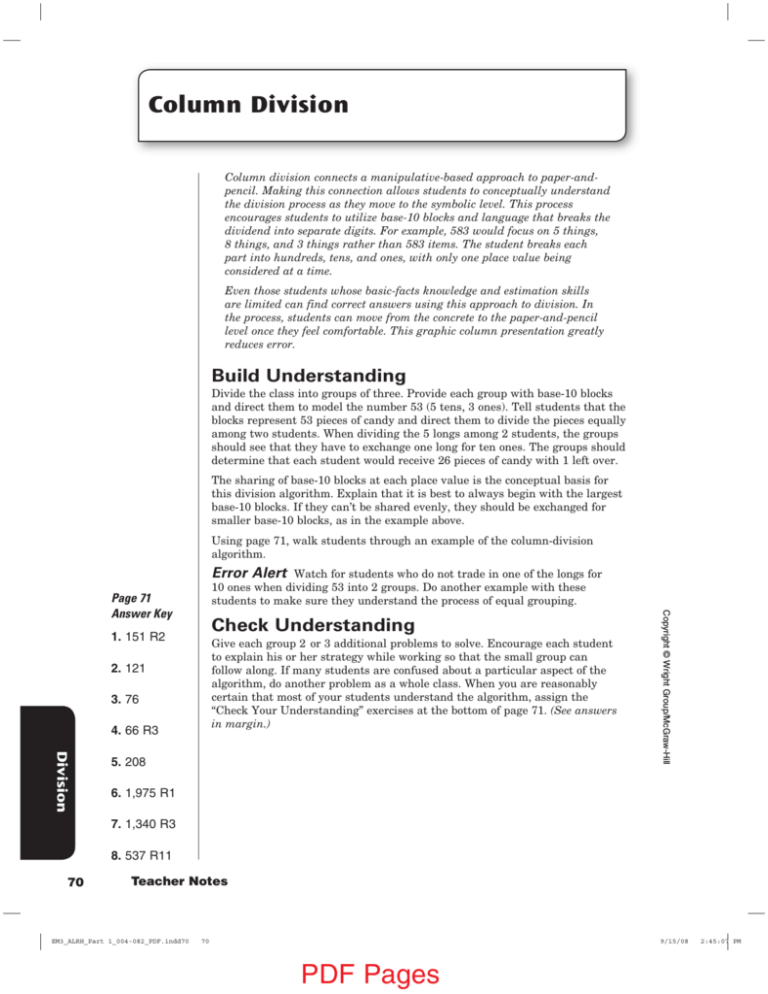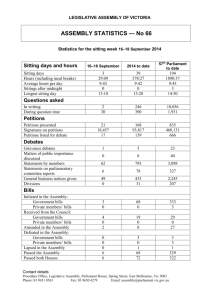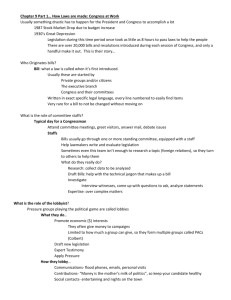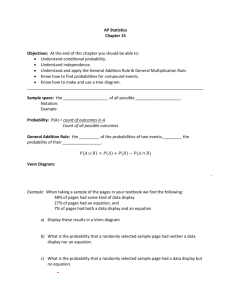Column Division
advertisement

Column Division Column division connects a manipulative-based approach to paper-andpencil. Making this connection allows students to conceptually understand the division process as they move to the symbolic level. This process encourages students to utilize base-10 blocks and language that breaks the dividend into separate digits. For example, 583 would focus on 5 things, 8 things, and 3 things rather than 583 items. The student breaks each part into hundreds, tens, and ones, with only one place value being considered at a time. Even those students whose basic-facts knowledge and estimation skills are limited can find correct answers using this approach to division. In the process, students can move from the concrete to the paper-and-pencil level once they feel comfortable. This graphic column presentation greatly reduces error. Build Understanding Divide the class into groups of three. Provide each group with base-10 blocks and direct them to model the number 53 (5 tens, 3 ones). Tell students that the blocks represent 53 pieces of candy and direct them to divide the pieces equally among two students. When dividing the 5 longs among 2 students, the groups should see that they have to exchange one long for ten ones. The groups should determine that each student would receive 26 pieces of candy with 1 left over. The sharing of base-10 blocks at each place value is the conceptual basis for this division algorithm. Explain that it is best to always begin with the largest base-10 blocks. If they can’t be shared evenly, they should be exchanged for smaller base-10 blocks, as in the example above. Using page 71, walk students through an example of the column-division algorithm. Error Alert Watch for students who do not trade in one of the longs for 10 ones when dividing 53 into 2 groups. Do another example with these students to make sure they understand the process of equal grouping. Check Understanding 1. 151 R2 Give each group 2 or 3 additional problems to solve. Encourage each student to explain his or her strategy while working so that the small group can follow along. If many students are confused about a particular aspect of the algorithm, do another problem as a whole class. When you are reasonably certain that most of your students understand the algorithm, assign the “Check Your Understanding” exercises at the bottom of page 71. (See answers in margin.) 2. 121 3. 76 4. 66 R3 Division 5. 208 Copyright © Wright Group/McGraw-Hill Page 71 Answer Key 6. 1,975 R1 7. 1,340 R3 8. 537 R11 70 Teacher Notes EM3_ALRH_Part 1_004-082_PDF.indd70 70 9/15/08 PDF Pages 2:45:07 PM Name Date Time Column Division In the example below, think of sharing $583 among 4 people. 1. Draw lines to separate the digits in the dividend. Work left to right. Begin in the left column. 2. Think of the 5 in the hundreds column as 5 $100 bills to be shared by 4 people. Each person gets 1 $100 bill. There is 1 $100 bill remaining. 1 4 5 3⎯ 8 -4 1 3. Trade the 1 $100 bill for 10 $10 bills. Think of the 8 in the tens column as 8 $10 bills. That makes 10 + 8 = 18 $10 bills in all. 1 4 5 3⎯ 8 -4 18 1 4. If 4 people share 18 $10 bills, each person gets 4 $10 bills. There are 2 $10 bills remaining. 5. Trade the 2 $10 bills for 20 $1 bills.Think of the 3 in the ones column as 3 $1 bills. That makes 20 + 3 = 23 $1 bills. 6. If 4 people share 23 $1 bills, each person gets 5 $1 bills.There are 3 $1 bills remaining. Record the answer as 145 R3. Each person receives $145 and $3 are left over. 1 4 4 5 3⎯ 8 -4 18 1 - 16 2 1 4 4 5 3⎯ 8 -4 23 18 1 - 16 2 1 4 5 4 5 8 3⎯ -4 18 23 1 - 16 - 20 2 3 Division Copyright © Wright Group/McGraw-Hill 4 5 8 3⎯ Check Your Understanding Solve the following problems. 1. 455 ÷ 3 2. 726 ÷ 6 3. 532 7 4. 267 4 5. 832 4 6. 3,951 ÷ 2 7. 6,703 5 8. 8,603 16 Write your answers on a separate sheet of paper. EM3_ALRH_Part 1_004-082_PDF.indd71 71 Student Practice 71 9/15/08 PDF Pages 2:45:07 PM





